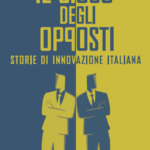As Europe adapts to the ‘new normal’ Professor Alberto Di Minin, Full Professor of Innovation Management at the Istituto di Management of the Scuola Superiore Sant’Anna, Pisa, says that he has seen evidence for optimism that knowledge-based companies are responding well to the challenges.
“We are currently reviewing how business strategies have changed over the last 100 days for across innovative SMES across Europe . This has given me hope for the future of Europe and that it will be as strong as before the pandemic.
“It has been beautiful to observe how SMEs throughout the continent have shown that they can be very specialised, very flexible and respond well within the most tragic of situations.

“Some of the entrepreneurs we have spoken to have felt ashamed to admit that the pandemic has been ‘great for them’, allowing them access to value chains where previously they had been shut out.
“Procurement processes have eased and very conservative sectors – health, aviation, tourism – are now open to innovation as they can’t afford not to be, and SMEs have a nice opportunity to set the agenda.”
Local specialisation global reach
Professor Di Minin’s particular research interest is how to establish the right conditions for entrepreneurial companies to grow; this might be through collaboration, through a platform technology or as a supplier. He comments: “We are seeing the development of innovation ecosystems, where there are complementary talents, and these are becoming a locus of innovation.”
“There has long been specialisation in certain areas of the world around particular industries and technologies, but now with the digital transformation it is becoming distributed and increasingly we will see special places scattered throughout the world, which offer the potential for very focused projects to have a global strength.
“Local specialisation is still a valuable ingredient, and I would encourage any regional authority to support and keep hold of this differentiator if they have it.”
Professor Di Minin says he retains the capacity to be surprised by the innovation process – “innovation enables the unexpected” – and this has many elements:
+ What it is possible to produce
+ How it will be exploited
+ Who will dominate the innovation
+ Where it happens
He comments that “many rising stars seem to come out of nowhere”. The ability to pivot, to change direction in response to market demand, is now more widely appreciated by larger companies who are learning from SMEs. “There is a trend to mimic this dynamic and create a start-up within the large company – we are seeing pockets of innovation emerging from established firms.
“As companies grow it is easy for them to lose the strength of focus. But to retain the innovative element they must get the right structure; if they can achieve this it is fantastic but the company needs ambidexterity to create momentum while also keep maintaining the business.
“One interesting model, which shows how large companies can benefit from external ideas is the Strategic Technology & Innovation Management (STIM) Consortium.”
STIM is a practice-oriented research and networking collaboration between industrial member companies and the Centre for Technology Management of the University of Cambridge.
“We have a collaboration with IfM of the University of Cambridge, looking at the dynamics between and within the companies and how they are benefiting from the support of a researcher at IfM. We are presenting a paper in the R&D Management Symposium in August about the mechanisms within the consortium and the value capture.”
A new emerging trend is a phenomenon described by Professor Di Minin as a ‘radical circle’, groups of enthusiasts that create a synergy, each making a contribution, and something incredible happens and a commercial opportunity emerges. “There is not just one way of collaborating and innovating and this ingenuity puzzle is forever surprising.”
If you are interested in the practical applications of innovation models and the implications for policy, Professor Di Minin has a number of papers on this subject. We asked him to pick four themes:
Policy: How to facilitate growth of the most promising SMEs, is a challenge for policymakers
Chiara Eleonora De Marco, Irene Martelli and Alberto Di Minin studied the EU Innovation Champions to determine if the European SME Instrument (SMEi) is achieving its goal of providing public funds to the best SMEs in Europe, and revealed that companies without the funding were more dynamic.
Professor Di Minin explains: “We tested our methodology on a sample of SMEs operating in the digital sector. We found that the SMEs awarded the grants are less engaged in the challenging dimensions of Open Innovation than companies that did not receive any funding. This is contrary to the intended goals of the grants.”
In the paper the researchers discuss the policy and methodological implications and make recommendations for a better OI-informed policy that would enable the more effective evaluation of companies participating in the SME Instrument. Professor Di Minin comments that, based on the results of this study, “we argue that EU policymakers should enhance the level of details required to identify the companies to be supported under the EIC Accelerator.
“Indicators such as the DeMarkers, which are proxies for measuring engagement in the four challenging dimensions of OI – Internal Assets Protection, Management of External Relations, Relatedness and Business Model Innovation – would help the identification of actual dynamism and engagement of the SMEs.”
European SMEs’ engagement in open innovation – When the important thing is to win and not just to participate, what should innovation policy do? Chiara Eleonora De Marco, Irene Martelli, Alberto Di Minin
Tradition: How do family firms overcome the barriers to knowledge acquisition?
An analysis of the family firm Loccioni revealed insights into the distinctive capabilities that allow these types of companies to overcome the barriers to knowledge acquisition and transfer when executing an OI strategy. These are the existence of non-economic goals and their unique social capital.
Imprinting refers to how the conditions at the time of an organisation’s founding can have a lasting impact on how the firm reacts to a changing environment. The founder’s vision and values are imprinted on and adopted by the second generation; this helps to identify the knowledge to acquire, the problems to solve and the ideas to focus on and are driven by the firm’s non-economic goals. This helps a family firm overcome the ‘inventor syndrome’ that is seen in other types of company.
The second element is fraternization – family firms have a family-like association with non-family members, which leads to a shared vision, trust, obligations and identification. These resources lead to easier information access and greater associability. The study provides some valuable managerial implications for family firm owners and managers. In particular delegation can help family firms react faster to technological change, increase their social capital and build relational trust. Firms should also be open to the opportunity that knowledge might diffuse in unconventional ways that offer new paths from which the organisation can profit. Co-development and open service innovation might represent valuable alternatives to create, share and profit from new knowledge.

How family firms execute open innovation strategies: the Loccioni case Elena Casprini, Alfredo De Massis, Alberto Di Minin, Federico Frattini, Andrea Piccaluga, Journal of Knowledge Management, ISSN: 1367-3270, Publication date: 9 October 2017 https://www.emerald.com/insight/content/doi/10.1108/JKM-11-2016-0515/full/html
Surprise effect: The diverse approaches to innovation
SMEs show a more dynamic approach to open innovation when compared to large companies, which typically have a strong focus on organisational and managerial levers. In contrast SMEs show a surprising diversity of models that are ‘solution orientated’, utilise creativity and faster product development and involve a greater number of partners and knowledge sources. These models integrate technologies, partnerships and complementary resources to enable risk-sharing and recovery of development costs. As a result researchers Cristina Marullo, Di Minin and colleagues concluded that SMEs’ innovation patterns differ according to the nature of the innovation project.
They identified three distinct patterns of innovation practice:
- Closed – this approach was taken when the project was cutting-edge technological advancement. Growth was linked to the capacity to explore and develop new technological knowledge (through R&D investment) and to extract value from technology assets (though IP protection). This strategy aims to maximise and fully appropriate the value of technology under development.
- Partner-orientated – this approach balanced internal R&D investment with collaborative innovation. Formal IP protection was used to enable this interaction and benefit from the expertise of partners. Growth was achieved through technology resources and the development of knowledge absorption capabilities and external partners are used in the exploitation and commercialisation phases.
- User-orientated – this approach revolves around the benefits gained by the users. In this model IP protection could be an obstacle to growth, and absorptive capacity was less important as the external communities provide ‘knowledge gatekeepers’. The opportunities for commercialising the external innovation created or co-developed came from realising utility for the end-users rather than the appropriation strategy. This study has strong practical implications. Although technology-based SME’s have a clear benefit from a balanced set of internal and collaborative innovation practices, different innovation patterns have different routes to growth.
Solving the heterogeneity puzzle: a comparative look at SMEs growth determinants in open and closed innovation patterns. International Journal of Entrepreneurship and Innovation Management 1(1):1 January 2019 DOI: 10.1504/IJEIM.2019.10025034
People: How rapid globalisation and best people are key factors in the success of start-ups
Survival is a key problem for start-ups especially in periods of uncertainty and volatility. Many studies look at the factors which determine the success or failure of a company, but few look at the synergy between the factors. Di Minin and his co-researchers took a resource-based view (RBV) to analyse four internal factors: advertising activity; export activity; human capital and R&D activity. The research found that of the various combinations the only one that impacts start-up survival is the interaction between export activity and human capital. The combination of these two internal resources allows start-ups to develop intangible capabilities and to achieve a competitive advantage that leads to their survival.
Born global and well educated: start-up survival through fuzzy set analysis https://link.springer.com/article/10.1007/s11187-019-00238-6
About
Alberto Di Minin is a Full Professor at the Istituto di Management of the Scuola Superiore Sant’Anna (Pisa, Italy) and a Research Fellow with the Berkeley Roundtable on the International Economy (BRIE, U.C. Berkeley). Alberto is the Director of Master MIND (Management and Innovation Design) at Scuola Sant’Anna (https://www.mindsantanna.it//) and a blogger for Italy’s main financial daily newspaper il Sole 24 Ore (https://albertodiminin.nova100.ilsole24ore.com/ Alberto’s research deals with the appropriability of innovation: (Open Innovation, new business models). https://www.linkedin.com/in/alberto-di-minin-0705104

